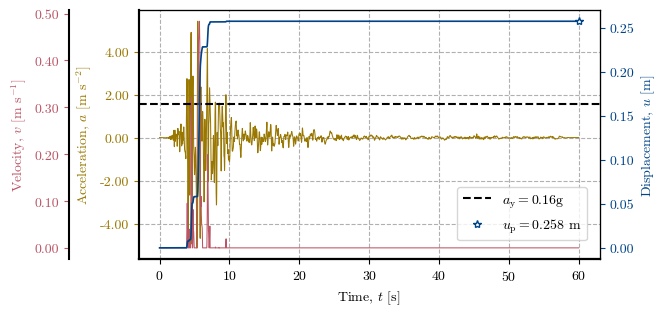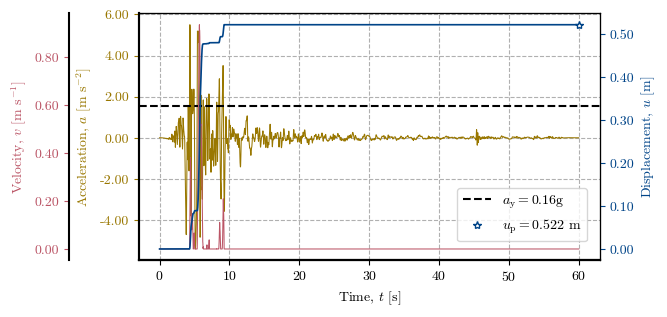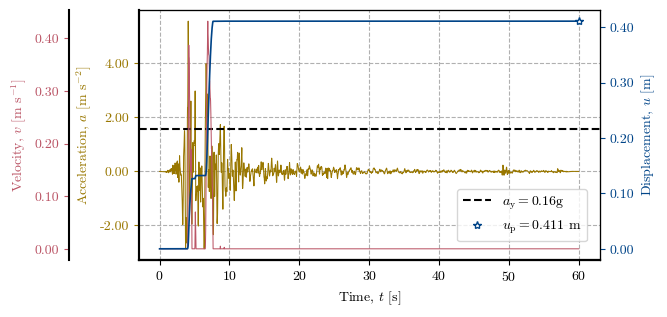Earthquake as a triggering factor in a spatial domain#
© 2024 Daniel F. Ruiz, Exneyder A. Montoya-Araque y Universidad EAFIT.
This notebook can be interactively run in Google - Colab.
This notebook runs the model pyNermarkDisp developed by Montoya-Araque et al. [2024] based on the classical sliding rigid block method by Newmark [1965].
Required modules and global setup for plots#
import subprocess
if 'google.colab' in str(get_ipython()):
print('Running on CoLab. Installing the required modules...')
# subprocess.run('pip install ipympl', shell=True);
subprocess.run('pip install pynewmarkdisp', shell=True);
from google.colab import output, files
output.enable_custom_widget_manager()
import numpy as np
import pandas as pd
import matplotlib as mpl
import matplotlib.pyplot as plt
from pynewmarkdisp.newmark import direct_newmark, plot_newmark_integration
from pynewmarkdisp.infslope import factor_of_safety, get_ky
from pynewmarkdisp.spatial import load_ascii_raster, map_zones, plot_spatial_field, spatial_newmark, get_idx_at_coords, verify_newmark_at_cell
from ipywidgets import widgets as wgt
# %matplotlib widget
%matplotlib inline
mpl.rcParams.update({
"font.family": "serif",
"font.serif": ["Computer Modern Roman", "cmr", "cmr10", "DejaVu Serif"], # or
"mathtext.fontset": "cm", # Use Computer Modern fonts for math
"axes.formatter.use_mathtext": True, # Use mathtext for axis labels
"axes.unicode_minus": False, # Use standard minus sign instead of a unicode character
})
Basic example#
Loading earthquake record and spatial data#
url = "https://raw.githubusercontent.com/eamontoyaa/data4testing/main/pynewmarkdisp/"
# Loading earthquake data
earthquake_record = pd.read_csv(f"{url}earthquake_data_simple.csv", sep=";")
earthquake_record = pd.read_csv(f"{url}earthquake_data_simple.csv", sep=";")
g = 1.0 # It means, accel units are given in fractions of gravity
accel = np.array(earthquake_record["Acceleration"])
time = np.array(earthquake_record["Time"])
# Loading spatial data
dem, header = load_ascii_raster(f"{url}spatial_data_dummy_example/dem.asc")
slope, header = load_ascii_raster(f"{url}spatial_data_dummy_example/slope.asc")
zones, header = load_ascii_raster(f"{url}spatial_data_dummy_example/zones.asc")
depth, header = load_ascii_raster(f"{url}spatial_data_dummy_example/zmax.asc")
depth_w, header = load_ascii_raster(f"{url}spatial_data_dummy_example/depthwt.asc")
Non-spatial inputs#
# Geotechnical parameters for each geological zone
parameters = { # Zone: (𝜙, 𝑐, 𝛾) → Follow this structure. Add as many zones as in the map "zones"
1: (35, 3.5, 22),
2: (31, 8, 22),
}
# Geographic reference system
# (Do not modify it if spatial data is loaded from ASCII raster, otherwise,
# modify the commented lines below)
spat_ref = header
# spat_ref = {
# 'xy_lowerleft': (header["xllcorner"], header["yllcorner"]),
# 'cell_size': header["cellsize"]
# }
# This is for enhancing the visualization of the results (contours)
contours = np.arange(70, 105, 5) # (min, max, step)
# Associating geotechnical parameters to each geological zone spatially and plotting
phi, c, gamma = map_zones(parameters, zones)
fig = plot_spatial_field(zones, dem, spat_ref=header, levels=contours,
title="Geological units", cmap='Dark2', discrete=True,
label=['Zone 1', 'Zone 2'], labelrot=90)
fig.canvas.header_visible = False
fig.canvas.toolbar_position = 'bottom'
plt.show()

# plotting the digital elevation model (dem)
fig = plot_spatial_field(dem, dem, spat_ref=header, levels=contours, labelrot=90,
title="Elevation [msnm]", cmap='terrain', discrete=False)
fig.canvas.header_visible = False
fig.canvas.toolbar_position = 'bottom'
plt.show()
# plotting the spatial distribution of slopes
fig = plot_spatial_field(slope, dem, spat_ref=header, levels=contours,
title="$\\delta\\ [^\\circ]$", cmap='RdYlGn_r', labelrot=90)
fig.canvas.header_visible = False
fig.canvas.toolbar_position = 'bottom'
plt.show()
# plotting the spatial distribution of potential sliding mass depths
fig = plot_spatial_field(depth, dem, spat_ref=header, levels=contours,
title="$Z_\\mathrm{max}$ [m]", cmap='viridis', labelrot=90)
fig.canvas.header_visible = False
fig.canvas.toolbar_position = 'bottom'
plt.show()
# plotting the spatial distribution of watertable depths
fig = plot_spatial_field(depth_w, dem, spat_ref=header, levels=contours,
title="$d$ [m]", cmap='viridis', labelrot=90)
fig.canvas.header_visible = False
fig.canvas.toolbar_position = 'bottom'
plt.show()
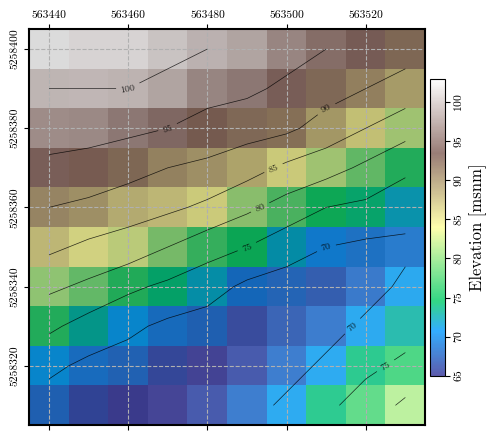
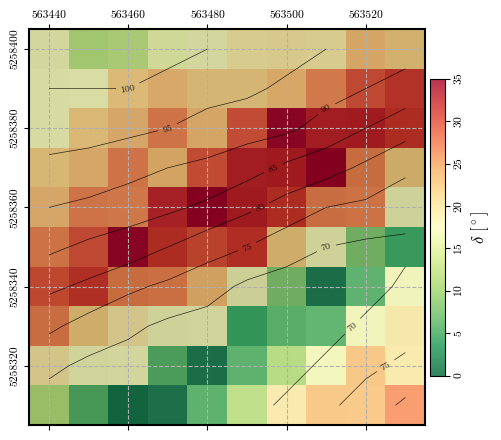
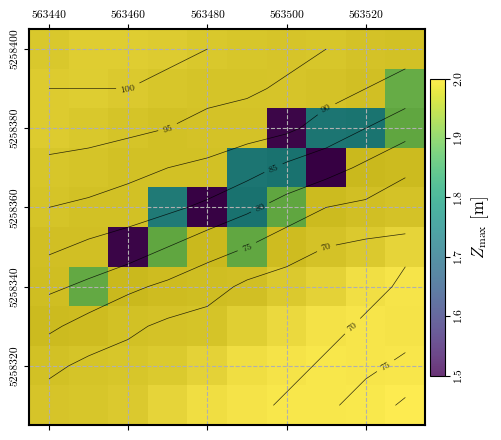
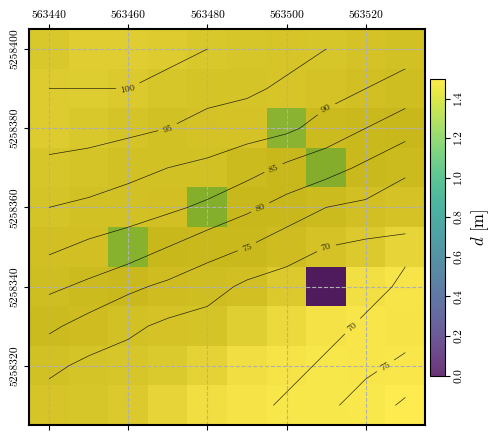
Calculating and plotting the spatial distribution of \(\mathrm{FS}_\mathrm{static}\)#
fs = factor_of_safety(depth, depth_w, slope, phi, c, gamma, ks=0)
fig = plot_spatial_field(fs, dem, spat_ref=header, levels=contours, cmap='RdYlGn',
title="$\\mathrm{FS}_\\mathrm{static}$", vmin=1.0, vmax=3.0, labelrot=90)
fig.canvas.header_visible = False
fig.canvas.toolbar_position = 'bottom'
plt.show()
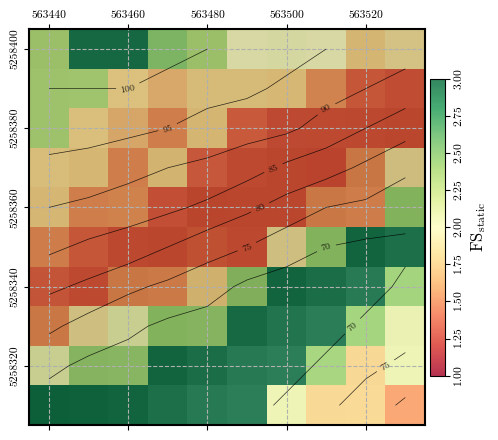
Calculating and plotting the spatial distribution of \(k_\mathrm{y}\)#
ky = get_ky(depth, depth_w, slope, phi, c, gamma)
fig = plot_spatial_field(ky, dem, spat_ref=header, levels=contours, cmap='RdYlGn',
title="$k_\\mathrm{y}$", labelrot=90)
fig.canvas.header_visible = False
fig.canvas.toolbar_position = 'bottom'
plt.show()
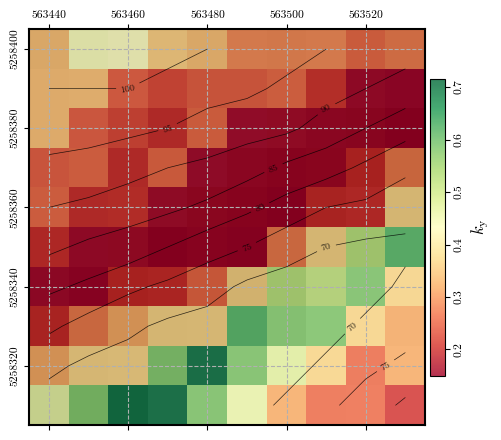
Calculating and plotting the spatial distribution of \(\mathrm{FS}_\mathrm{pseudostatic}\) when \(k_\mathrm{s}\) is 40% of \(k_\mathrm{y}\)#
# Calculating factor of safety for pseudostatic conditions and plotting its spatial distribution
ks = 0.4 * ky
fig = plot_spatial_field(ks, dem, spat_ref=header, levels=contours, cmap='RdYlGn',
title="$k_\\mathrm{s} = 0.4 k_\\mathrm{y}$", labelrot=90)
fig.canvas.header_visible = False
fig.canvas.toolbar_position = 'bottom'
plt.show()
fs_ks = factor_of_safety(depth, depth_w, slope, phi, c, gamma, ks=ks)
fig = plot_spatial_field(fs_ks, dem, spat_ref=header, levels=contours, cmap='RdYlGn',
title="$\\mathrm{FS}_\\mathrm{pseudostatic}$", vmin=1.0, vmax=3.0, labelrot=90)
fig.canvas.header_visible = False
fig.canvas.toolbar_position = 'bottom'
plt.show()
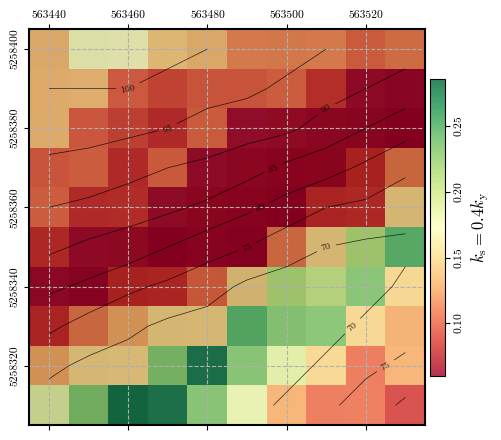
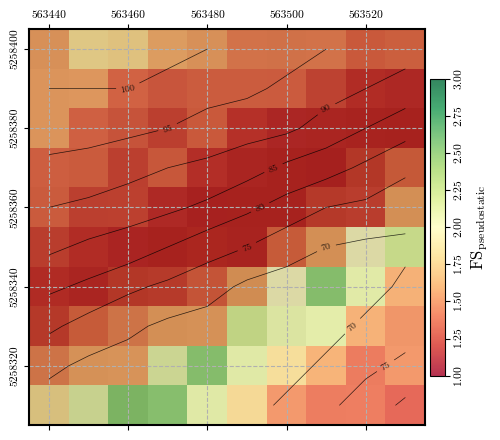
Calculating and plotting the spatial distribution of \(u_\mathrm{p}\)#
# Calculating permanent displacements and plotting its spatial distribution
permanent_disp = spatial_newmark(time, accel, ky, g)
fig = plot_spatial_field(permanent_disp, dem, spat_ref=header, levels=contours,
title="$u_\\mathrm{p}$ [m]", cmap='RdYlGn_r', labelrot=90)
# axis_labels = fig.get_axes()[0].get_xticklabels() + fig.get_axes()[0].get_yticklabels()
# [label.set_fontsize('large') for label in axis_labels]
fig.canvas.header_visible = False
fig.canvas.toolbar_position = 'bottom'
plt.show()
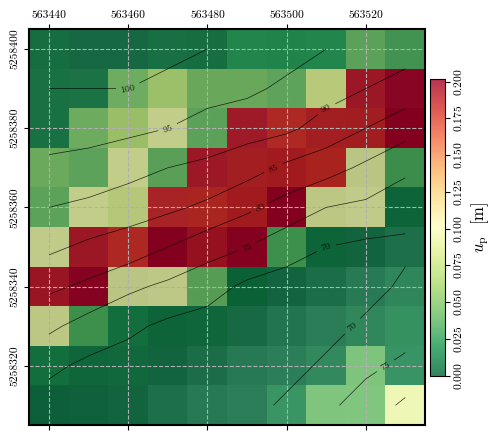
Plotting the Newmark method at a specific location#
# Verification of the Direct Newmark Method at one cell
x, y = 563500, 5258380 # Coordinates of the cell to verify
cell = get_idx_at_coords(x=x, y=y, spat_ref=header) # Cell to verify
print(f"Zone: {zones[cell]}, Height: {dem[cell]}, Slope: {slope[cell]}°, FS: {fs[cell]}, kᵧ: {ky[cell]}, uₚ: {permanent_disp[cell]}")
# zones[cell], dem[cell], slope[cell], fs[cell], ky[cell], permanent_disp[cell])
# Plotting the Newmark method at the cell (three plots)
newmark_str = verify_newmark_at_cell(cell, time, accel, g, depth, depth_w, slope, phi, c, gamma)
fig = plot_newmark_integration(newmark_str)
fig.canvas.header_visible = False
fig.canvas.toolbar_position = 'bottom'
plt.show()
# Plotting the Newmark method at the cell (single compressed plot)
# fig = plot_newmark_integration(newmark_str, True)
# fig.canvas.header_visible = False
# fig.canvas.toolbar_position = 'bottom'
# plt.show()
Zone: 2.0, Height: 91.0, Slope: 35.0°, FS: 1.323, kᵧ: 0.159, uₚ: 0.183
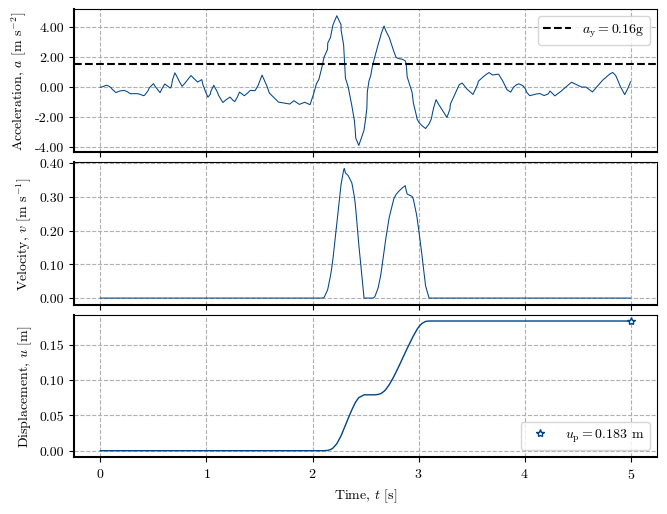
Comparing three signals with \(a_\mathrm{max} = 5.5 \pm 0.1\) \(\mathrm{m/s}^2\)#
url = "https://raw.githubusercontent.com/eamontoyaa/data4testing/main/pynewmarkdisp/"
# Loading earthquake data
g = 9.81 # → It means, accel units are given in [m/s²]
record_1 = np.loadtxt(f"{url}earthquake_record_FLC049_amax5.5.txt")
record_1_time, record_1_accel = record_1[:, 0], record_1[:, 1]
record_2 = np.loadtxt(f"{url}earthquake_record_FLC050_amax5.5.txt")
record_2_time, record_2_accel = record_2[:, 0], record_2[:, 1]
record_3 = np.loadtxt(f"{url}earthquake_record_FLC057_amax5.5.txt")
record_3_time, record_3_accel = record_3[:, 0], record_3[:, 1]
print(f"a_max record 1: {record_1_accel.max():.2f} m/s² | a_max record 2: {record_2_accel.max():.2f} m/s² | a_max record 3: {record_3_accel.max():.2f} m/s²")
a_max record 1: 5.41 m/s² | a_max record 2: 5.50 m/s² | a_max record 3: 5.56 m/s²
Calculating and plotting the spatial distribution of \(u_\mathrm{p}\)#
record_1_uₚ = spatial_newmark(record_1_time, record_1_accel, ky, g)
record_2_uₚ = spatial_newmark(record_2_time, record_2_accel, ky, g)
record_3_uₚ = spatial_newmark(record_3_time, record_3_accel, ky, g)
vmax = np.nanmax([record_1_uₚ, record_2_uₚ, record_3_uₚ])
fig = plot_spatial_field(record_1_uₚ, dem, spat_ref=header, levels=contours,
title="$u_\\mathrm{p}$ [m] (Record 1)", cmap='RdYlGn_r',
labelrot=90, vmin= 0, vmax=vmax)
fig.canvas.header_visible = False
fig.canvas.toolbar_position = 'bottom'
plt.show()
fig = plot_spatial_field(record_2_uₚ, dem, spat_ref=header, levels=contours,
title="$u_\\mathrm{p}$ [m] (Record 2)", cmap='RdYlGn_r',
labelrot=90, vmin= 0, vmax=vmax)
fig.canvas.header_visible = False
fig.canvas.toolbar_position = 'bottom'
plt.show()
fig = plot_spatial_field(record_3_uₚ, dem, spat_ref=header, levels=contours,
title="$u_\\mathrm{p}$ [m] (Record 3)", cmap='RdYlGn_r',
labelrot=90, vmin= 0, vmax=vmax)
fig.canvas.header_visible = False
fig.canvas.toolbar_position = 'bottom'
plt.show()

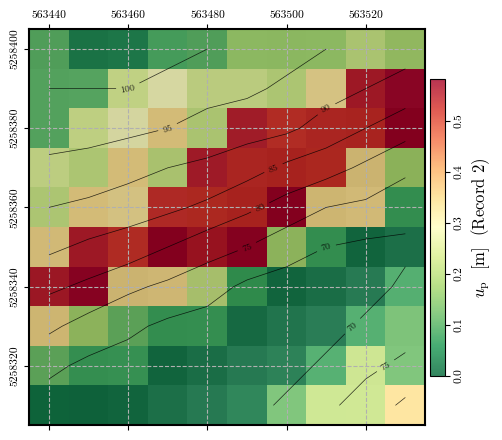
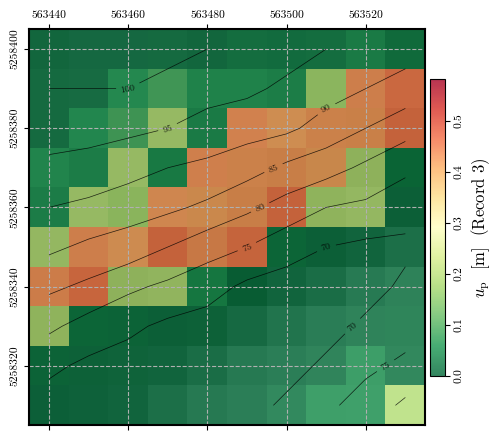
Plotting the Newmark method at a specific location#
# Verification of the Direct Newmark Method at one cell
x, y = 563500, 5258380 # Coordinates of the cell to verify
cell = get_idx_at_coords(x=x, y=y, spat_ref=header) # Cell to verify
print(f"Zone: {zones[cell]}, Height: {dem[cell]}, Slope: {slope[cell]}°, FS: {fs[cell]}, kᵧ: {ky[cell]}")
print(f"uₚ (record 1): {record_1_uₚ[cell]} | uₚ (record 2): {record_2_uₚ[cell]} | uₚ (record 3): {record_3_uₚ[cell]}")
# Plotting the Newmark method at the cell (single compressed plot)
newmark_str_record_1 = verify_newmark_at_cell(cell, record_1_time, record_1_accel, g, depth, depth_w, slope, phi, c, gamma)
fig = plot_newmark_integration(newmark_str_record_1, True)
fig.canvas.header_visible = False
fig.canvas.toolbar_position = 'bottom'
plt.show()
newmark_str_record_2 = verify_newmark_at_cell(cell, record_2_time, record_2_accel, g, depth, depth_w, slope, phi, c, gamma)
fig = plot_newmark_integration(newmark_str_record_2, True)
fig.canvas.header_visible = False
fig.canvas.toolbar_position = 'bottom'
plt.show()
newmark_str_record_3 = verify_newmark_at_cell(cell, record_3_time, record_3_accel, g, depth, depth_w, slope, phi, c, gamma)
fig = plot_newmark_integration(newmark_str_record_3, True)
fig.canvas.header_visible = False
fig.canvas.toolbar_position = 'bottom'
plt.show()
Zone: 2.0, Height: 91.0, Slope: 35.0°, FS: 1.323, kᵧ: 0.159
uₚ (record 1): 0.258 | uₚ (record 2): 0.522 | uₚ (record 3): 0.411
